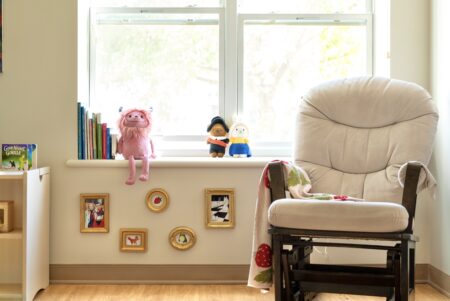I grew up in the online church.
No, really. My first Bible study was a remote, online study hosted by a mom blogger I liked, back when I was in high school. It was me, a seventeen-year-old who had been to church twice in her life, and a group of forty-five-year-old moms in Tennessee. In the first pre-recorded video, the Bible study leader told us to flip to Acts 12:15.
“Acts in which book?” I wondered, as I watched the women on screen dutifully flip to the same page in their Bibles. I was so unfamiliar with the text that I thought an ‘act’ was the word for a verse. To my ears, it was like she had told everyone to flip to “verse seven,” and I just had to nod and pretend to follow along.
I started going to a real, physical church later that year, when my friend Shannon brought me to hers. It was a little white building down the road from my house. I loved that church, which in some ways was so very different from the highly-produced sermons I found online — with their swelling music, stage lights, and epic trailers for the newest series on Jonah or Mark. This church felt real. Full of real people who knew me by name; who were personally responsible for various coffee stains on the carpet; who once asked me to recite the reading of the day because it was from Leviticus, and they thought my characteristically upbeat tone would soften the blow.
I felt known in a way I couldn’t as one of a thousand readers or viewers on the Internet.

But I was in college. My location changed all the time, from Massachusetts to England to the Netherlands, and so my in-person attendance was necessarily sporadic. So the ‘online church’ filled the gaps for me, patching holes and creating bridges when I felt lost or lonely. I devoured books and blog posts by people like Rachel Held Evans, Jen Hatmaker, and Jeff Chu, and videos by the Bible Project. Podcasts, digital services, and online bible studies built up my faith when in-person fellowship couldn’t. And, when I missed the familiar rhythms of my old church too much, I’d catch up on the recordings of their latest service, watching through a screen an ocean away.
All this to say: I don’t think I’d be a Christian without the Internet. And I know that my online community wouldn’t be nearly the same if I wasn’t a Christian. Because as I was growing up and growing in faith, I was writing about it on this blog. My readership grew. At some point I started Advent Illustrated, which turned into a series of seven Bible studies and a community of 5,000 people.
Basically, I was now part of the online church from both the pews and the pulpit.

I may be one of the first people for whom the ‘online church’ was their first spiritual home, if only because I’m in the first generation to grow up online. But that experience has become more and more common, at the same time that the Christian world grapples with the effects and implications of an increasingly digital world.
And now, of course, that conversation looks radically different than it did a year ago. Almost all our churches are remote. Pastors are struggling to offer care to their parishioners, and congregants are struggling to find community, in a new medium. We’re all in the ‘online church’ now, whether we like it or not.
At the start of the pandemic, I decided to attend online services at churches from different traditions than my own, as a way to enrich and broaden my vocabulary of faith. As lockdown continued, I tried to find a more permanent online spiritual home by ‘joining’ a friend for her church’s livestreams. But eventually, I burnt out. She did, too. A livestream just doesn’t feel like church, after a while — especially when our whole lives are behind a screen, and I find myself aching for things that feel tangible and real.
And then, this week, my friend Shannon sent me a link to my old home church’s weekly Zoom service.
I’d been getting their emails each week for years (I could never bring myself to unsubscribe from the mailing list), but I had never joined in for the weekly service. The church had changed a lot since I moved abroad — some families had left, and my old pastors had moved to other churches in different states. I didn’t think many people would recognize me now. And because the services were on Zoom, it felt somehow invasive to insert myself into this community from afar, when I hadn’t been there in so long. I couldn’t watch passively, like in a video or livestream. The service was on Zoom. It necessitated being seen.
But Shannon invited me, so I showed up, with my webcam on. And it was wonderful.
We sang the old familiar hymns I knew. We followed the structure I’d grown accustomed to over years of services here. We sang the doxology and closing song I’ve known by heart since high school.
But that wasn’t what felt like church. What felt like church was the people. No livestream, no stage lights, no best angles. Families fiddling with the webcam. Distracted babies. Shrieking kids in the background during Joys and Concerns.
At the end of the service, we all turned our microphones on and said the Lord’s Prayer together, the audio becoming disjointed, cutting in and out at the chorus of different human voices. It wasn’t glamorous in the way that pre-recorded, edited-together services can sometimes be. But it was wonderfully real. And it reminded me of something I should have known before, but had never stopped to realize.

Zoom captures a big part of what church is about. It includes the mess, the real people, and the real relationships in a way that livestreams and YouTube videos cannot. It shows the coffee stains. It necessitates being seen.
This was what always ‘worked’ about the online church to begin with. It was what made the voices and communities I found online a salve — not their hyper-smooth perfection, but their honesty; the raw, unedited truth of their lived experiences, which at times echoed or wildly diverged from my own. In church, in person as online, we are all in some ways in both the pews and the pulpit. We both receive and proclaim the gospel as we listen to and see each other; as we humble ourselves by being seen as we are.
Church was never meant to be observational. It’s relational, because it’s about what happens among and between us when we take the time to be together.
Somewhere down the road, in joining in for livestreams and video services, I’d forgotten that a church is not a space, but a community. And when we sit passively, watching it before our eyes but not joining in, we lose a big part of what the gospel is about. Because God, too, is not observational, but relational. And church isn’t just for the well-groomed ladies flipping to Acts in unison, but also for those of us who have no idea what Acts is. Not just for the in-crowd, but for the rest of us.
When I leave out the mess, when I turn the webcam off, I forget. The church isn’t polished, and the gospel isn’t pre-recorded. It happens here, among and between us, with our coffee stains and distracted babies, our mess and beauty, in full view.






Church was never meant to be observational. It’s relational, because it’s about what happens among and between us when we take the time to be together.
This really got my attention….so much so I wrote it down in my Bible Journal. Thank you for your insights.